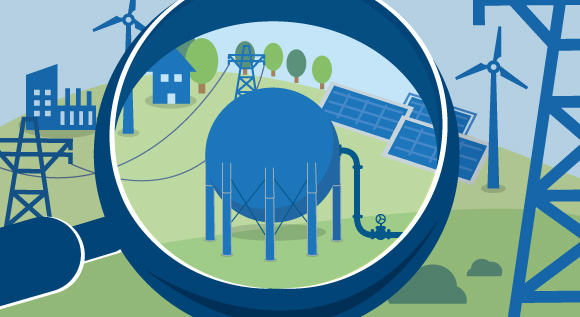What exactly is power-to-gas?
Is there any way in which we can convert electricity from wind and solar energy into other forms of energy and therefore store it permanently? Power-to-gas technology could be the solution! In the following, we’ll explain to you how this works.
 © BMWi
© BMWiIt’s about converting electricity into gas and storing it
As the proportion of electricity generated from renewables rises, it becomes more important to make sure that we have an electricity system that can respond to fluctuations in a flexible way. When there is so much wind that our wind turbines are producing more electricity than is needed, we can respond, for example, by employing demand-side management measures (to find out more about this, please click here) or making electricity generation more flexible. Another option is to convert electricity into another form of energy – for example by using power-to-gas technology. The idea behind this is that electricity is converted into a gas, such as hydrogen, that can be stored in the gas network. So by converting it into gas, the electricity can be used. Power-to-gas technology is still expensive and has a low efficiency, which means that some energy is lost in the conversion process.
And for those of you who want to know more about how exactly electricity is converted into gas, here are a few more details: Electricity is applied to split water into its component parts, water and oxygen. This procedure is called electrolysis. In its molecular form, hydrogen is a colourless, odourless gas. In an additional step, high temperature and high pressure is applied to the gas to trigger a chemical reaction with carbon dioxide and convert the gas into methane.
Gas can be used directly or reconverted into electricity
The gas that is produced in this way can be used in industry, for heating homes or for propelling vehicles. Hydrogen can be used in vehicles that use fuel cell drive systems, while methane can be used in vehicles that run on natural gas. Gas can also be reconverted into electricity by using a turbine. However, converting and reconverting the gas several times means that large amounts of energy will be lost.
While artificially-produced methane can be fed into the natural gas grid and stored there without any limits, only small amounts of hydrogen can be integrated.
Power-to-gas is one of several flexibility options
Power-to-gas can help balance electricity generation and demand. However, as there are also other flexibility options such as expanding the grid or employing demand-management measures, it is up to the market to decide which option is used in a particular situation. The Act on the Further Development of the Electricity Market, which was adopted in 2016, puts the rules in place for competition between flexible supply, flexible demand, and storage and makes our electricity supply fit for growing shares of renewable energy.

